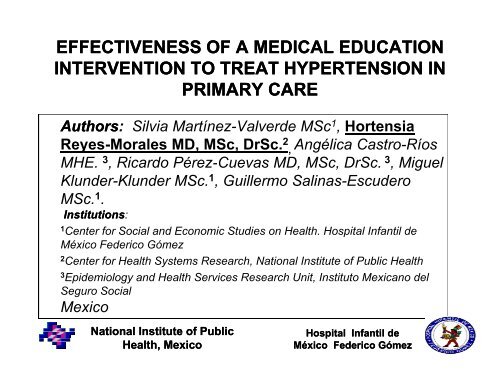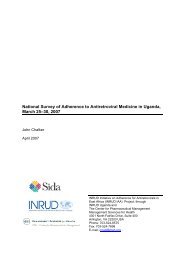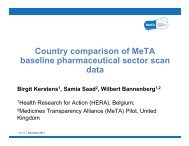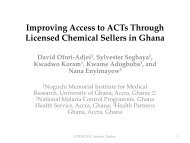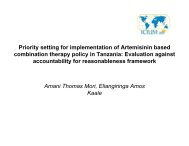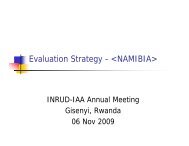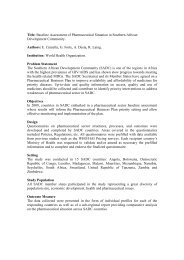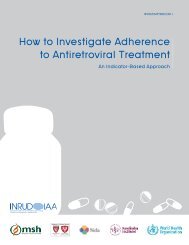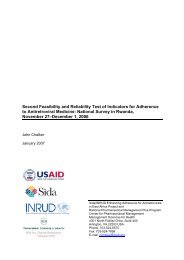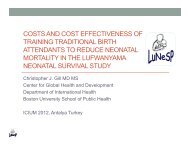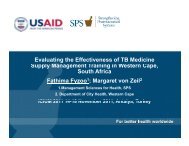448-MartÃnez Valverde-_c.pdf - INRUD
448-MartÃnez Valverde-_c.pdf - INRUD
448-MartÃnez Valverde-_c.pdf - INRUD
You also want an ePaper? Increase the reach of your titles
YUMPU automatically turns print PDFs into web optimized ePapers that Google loves.
EFFECTIVENESS OF A MEDICAL EDUCATION<br />
INTERVENTION TO TREAT HYPERTENSION IN<br />
PRIMARY CARE<br />
Authors: Silvia Martínez-<strong>Valverde</strong> MSc 1 , Hortensia<br />
Reyes-Morales MD, MSc, DrSc. 2 , Angélica Castro-Ríos<br />
MHE. 3 , Ricardo Pérez-Cuevas MD, MSc, DrSc. 3 , Miguel<br />
Klunder-Klunder MSc. 1 , Guillermo Salinas-Escudero<br />
MSc. 1 .<br />
Institutions:<br />
1<br />
Center for Social and Economic Studies on Health. Hospital Infantil de<br />
México Federico Gómez<br />
2<br />
Center for Health Systems Research, National Institute of Public Health<br />
3<br />
Epidemiology and Health Services Research Unit, Instituto Mexicano del<br />
Seguro Social<br />
Mexico<br />
National Institute of Public<br />
Health, Mexico<br />
Hospital Infantil de<br />
México Federico Gómez
Introduction<br />
• In México, hypertension is among the top five causes of<br />
visit to primary care clinics, and its complications are<br />
among the main causes of emergency services and<br />
hospital care.<br />
• The interventions to tackle this growing problem<br />
comprise public health programs that include prevention<br />
and health promotion activities and screening.<br />
• Public healthcare systems have developed evidence-<br />
based clinical guidelines in accordance with international<br />
recommendations, but suitable for local use during their<br />
daily practice.<br />
National Institute of<br />
Public Health, Mexico<br />
Hospital Infantil de<br />
México Federico Gómez
Introduction<br />
•The guidelines have been used as a tool in<br />
continuing i medical education programs, and it is<br />
expected that practitioners would use them.<br />
• Continuing medical education (CME) consists of<br />
educational activities that serve to maintain, develop,<br />
or increase the knowledge, skills, and professional<br />
performance and relationships that a medical doctor<br />
uses to provide services to the patients.<br />
National Institute of<br />
Public Health, Mexico<br />
Hospital Infantil de<br />
México Federico Gómez
Objective<br />
• To<br />
evaluate<br />
the<br />
effectiveness<br />
of a continuing<br />
medical education (CME) intervention to improve<br />
appropriate care for hypertension, on blood pressure<br />
control<br />
clinics.<br />
of<br />
hypertensive<br />
patients<br />
in<br />
primary<br />
care<br />
National Institute of<br />
Public Health, Mexico<br />
Hospital Infantil de<br />
México Federico Gómez
Methods<br />
• Design: A secondary data analysis was carried out<br />
using data of hypertensive patients treated by family<br />
physicians who participated in the Continuing<br />
Medical Education intervention.<br />
• Setting: The study was conducted d at a national level<br />
l<br />
in six family medical clinics belonging to the Mexican<br />
Institute of Social Security (IMSS), the largest public<br />
health care system in Mexico.<br />
National Institute of<br />
Public Health, Mexico<br />
Hospital Infantil de<br />
México Federico Gómez
Methods<br />
• Study Population: The analysis included 193<br />
patients with hypertension (intervention group: n =<br />
101 patients; control group: n = 92 patients), who<br />
were treated by 90 physicians.<br />
• Intervention: The intervention was based on three<br />
sequential stages that t lasted 3 months. In each<br />
setting, a general internal medicine specialist was<br />
trained to coordinate the interventions and to work as<br />
a clinical instructor.<br />
National Institute of<br />
Public Health, Mexico<br />
Hospital Infantil de<br />
México Federico Gómez
Methods<br />
• An evidence-based clinical guideline was<br />
previously designed and adapted to the family<br />
medicine context and served as the groundwork for<br />
the intervention.<br />
• Analysis: The effect of the CME intervention was<br />
analyzed using multiple logistic regression modeling<br />
in which the dependent variable was uncontrolled<br />
blood pressure in the post-intervention patient<br />
measurement.<br />
National Institute of<br />
Public Health, Mexico<br />
Hospital Infantil de<br />
México Federico Gómez
Methods<br />
• The operational definition of uncontrolled blood<br />
pressure states that the systolic/diastolic figures<br />
should be ≥140/90 mmHg5.<br />
• Outcome measure : Proportion of patients with<br />
uncontrolled blood pressure in the intervention and<br />
control groups at baseline and final stages.<br />
National Institute of<br />
Public Health, Mexico<br />
Hospital Infantil de<br />
México Federico Gómez
Results: Baseline characteristics<br />
General characteristics Intervention Control<br />
n=101 n=92<br />
Mean (SD) Mean (SD)<br />
Age (years) 58.88 (12.9) 58.7 (9.3)<br />
% %<br />
Sex<br />
Men 19.8 20.7<br />
Women 80.2 79.4<br />
Civil status<br />
Single, widowed* 45.5 25.0<br />
Married or consensual union 54.55 75.0<br />
Literacy<br />
Up to 3 years of primary school 63.4 67.4<br />
Elementary school completed 12.9 18.5<br />
Secondary school 18.8 7.6<br />
High school 3.0 2.2<br />
College graduates 2.0 4.4<br />
National Institute of<br />
Public Health, Mexico<br />
* p
Results: Baseline Clinical Data<br />
Variables Intervention Control<br />
n=101 n=92<br />
Clinical data Mean (SD) Mean (SD)<br />
Blood pressure (mmHg)<br />
Systolic 135.5 (15.8) 136.6 (13.6)<br />
Diastolic 83.7 (8.6) 84.8 (7.9)<br />
Biochemical indicators (mg/dL)<br />
Glucose 108.5 (29.5) 110.8 (39.7)<br />
Total Cholesterol 211.9 (44.8) 214.7 (50.0)<br />
Triglycerides 227.5 (131.7) 215.0 (98.0)<br />
Comorbidity<br />
Diabetes 8.91 11.96<br />
Cardiopathy 10.89 4.35<br />
Duration of hypertension (years)<br />
≤ 5 38.5 33.0<br />
5-9 27.1 26.1<br />
10-14 14.6 23.9<br />
15-19 19 8.3 13.6<br />
≥20 11.5 3.4<br />
Blood pressure control<br />
Controlled patients 38.6 30.4<br />
Nutritional status<br />
Normal 19.8 9.8<br />
Overweight 33.7 37.0<br />
Obesity 46.5 53.3
Results:<br />
Patients with uncontrolled blood pressure in both<br />
groups at baseline and final evaluation stages<br />
.<br />
pp: percentage points<br />
p: p value between groups<br />
National Institute of<br />
Public Health, Mexico<br />
Hospital Infantil de<br />
México Federico Gómez
Multiple Logistic Regression Model: CME<br />
intervention with uncontrolled blood pressure<br />
Variables included in the<br />
final model<br />
Odds ratio 95% confidence<br />
p > z<br />
interval<br />
CME educational<br />
0.47 0.24 0.90 0.02<br />
intervention<br />
Baseline uncontrolled blood<br />
2.66 1.31 5.38 0.01<br />
pressure<br />
Baseline body mass index 1.07 1.001 1.143 0.04<br />
Women 0.46 0.20 1.06 0.07<br />
Age (years) 1.03 0.99 1.06 0.11<br />
Dietary recommendations at<br />
the baseline evaluation<br />
Hosmer-Lemeshow<br />
goodness of fit, Prob > χ 2 = 0.5683<br />
0.43 0.22 0.87 0.02<br />
National Institute of<br />
Public Health, Mexico<br />
Hospital Infantil de<br />
México Federico Gómez
• The<br />
intervention<br />
Conclusions<br />
analysis demonstrated that a multifaceted<br />
of<br />
CME<br />
increase<br />
the<br />
probability<br />
control blood pressure in hypertensive patients.<br />
to<br />
• The results highlight the importance of providing<br />
dietary recommendations. Dietary recommendations<br />
are a proxy that can be used to ascertain whether<br />
patients t change their dietary habits to control their<br />
body weight and decrease their blood pressure.<br />
National Institute of<br />
Public Health, Mexico<br />
Hospital Infantil de<br />
México Federico Gómez


